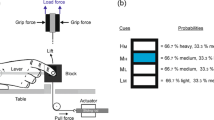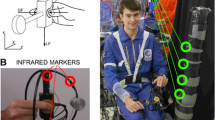Abstract
Advance information, such as object weight, size and texture, modifies predictive scaling of grip forces in a grip-lift task. Here, we examined the influence of probabilistic advance information about object weight. Fifteen healthy volunteers repeatedly grasped and lifted an object equipped with a force transducer between their thumb and index finger. Three clearly distinguishable object weights were used. Prior to each lift, the probabilities for the three object weights were given by a visual cue. We examined the effect of probabilistic pre-cues on grip and lift force dynamics. We expected predictive scaling of grip force parameters to follow predicted values calculated according to probabilistic contingencies of the cues. We observed that probabilistic cues systematically influenced peak grip and load force rates, as an index of predictive motor scaling. However, the effects of probabilistic cues on force rates were nonlinear, and anticipatory adaptations of the motor output generally seemed to overestimate high probabilities and underestimate low probabilities. These findings support the suggestion that anticipatory adaptations and force scaling of the motor system can integrate probabilistic information. However, probabilistic information seems to influence motor programs in a nonlinear fashion.




Similar content being viewed by others
References
Ameli M, Dafotakis M, Fink GR, Nowak DA (2008) Predictive force programming in the grip-lift task: the role of memory links between arbitrary cues and object weight. Neuropsychologia 46(9):2383–2388
Baugh LA, Kao M, Johansson RS, Flanagan JR (2012) Material evidence: interaction of well-learned priors and sensorimotor memory when lifting objects. J Neurophysiol 108(5):1262–1269
Bensmail D, Sarfeld AS, Ameli M, Fink GR, Nowak DA (2012) Arbitrary visuomotor mapping in the grip-lift task: dissociation of performance deficits in right and left middle cerebral artery stroke. Neuroscience 210:128–136
Brouwer AM, Georgiou G, Glover S, Castiello U (2006) Adjusting reach to lift movements to sudden visible changes in target’s weight. Exp Brain Res 173:629–636
Buckingham G, Cant JS, Goodale MA (2009) Living in a material world: how visual cues to material properties affect the way that we lift objects and perceive their weight. J Neurophysiol 102:3111–3118
Chouinard PA, Leonard G, Paus T (2005) Role of the primary motor and dorsal premotor cortices in the anticipation of forces during object lifting. J Neurosci 25(9):2277–2284
Cole KJ, Rotella DL (2002) Old age impairs the use of arbitrary visual cues for predictive control of fingertip forces during grasp. Exp Brain Res 143(1):35–41
Davidson PR, Wolpert DM (2004) Internal models underlying grasp can be additively combined. Exp Brain Res 155(3):334–340
Eastough D, Edwards MG (2007) Movement kinematics in prehension are affected by grasping objects of different mass. Exp Brain Res 10(6):193–198
Gordon AM, Westling G, Cole KJ, Johansson RS (1993) Memory representations underlying motor commands used during manipulation of common and novel objects. J Neurophysiol 69(6):1789–1796
Jenmalm P, Schmitz C, Forssberg H, Ehrsson HH (2006) Lighter or heavier than predicted: neural correlates of corrective mechanisms during erroneously programmed lifts. J Neurosci 26(35):9015–9021
Johansson RS, Flanagan R (2009) Sensory control of object manipulation. In: Nowak D, Hermsdörfer J (eds) Sensorimotor control of grasping. Cambridge University Press, Cambridge, pp 141–160
Johansson RS, Westling G (1988) Coordinated isometric muscle commands adequately and erroneously programmed for the weight during lifting task with precision grip. Exp Brain Res 71(1):59–71
Kuhtz-Buschbeck JP, Gilster R, Wolff S, Ulmer S, Siebner H, Jansen O (2008) Brain activity is similar during precision and power gripping with light force: an fMRI study. Neuroimage 40:1469–1481
Li Y, Randerath J, Bauer H, Marquardt C, Goldenberg G, Hermsdörfer J (2009) Object properties and cognitive load in the formation of associative memory during precision lifting. Behav Brain Res 196(1):123–130
Mon-Williams M, Murray AH (2000) The size of the visual size cue used for programming manipulative forces during precision grip. Exp Brain Res 135:405–410
Nowak DA, Koupan C, Hermsdörfer J (2007) Formation and decay of sensorimotor and associative memory in object lifting. Eur J Appl Physiol 100(6):719–726
Nowak DA, Glasauer S, Hermsdörfer J (2013) Force control in object manipulation—a model for the study of sensorimotor control strategies. Neurosci Biobehav Rev 37(8):1578–1586
Oldfield RC (1971) The assessment and analysis of handedness: the Edinburgh inventory. Neuropsychologia 9(1):97–113
Peirce JW (2007) PsychoPy—psychophysics software in Python. J Neurosci Methods 162(1–2):8–13
R Development Core Team (2008) R: a language and environment for statistical computing. R Foundation for Statistical Computing, Vienna, Austria. http://www.R-project.org
Stevens SS (1971) Sensory power functions and neural events. In: Autrum H, Jung R, Loewenstein WR, MacKay DM, Teuber HL (eds) Handbook of sensory physiology, vol 1, 1st edn. Springer, Heidelberg, pp 226–242
Van Nuenen BF, Kuhtz-Buschbeck J, Schulz C, Bloem BR, Siebner HR (2012) Weight-specific anticipatory coding of grip force in human dorsal premotor cortex. J Neurosci 32:5272–5283
Westwood DA, Heath M, Roy EA (2000a) The effect of a pictorial illusion on closed-loop and open-loop prehension. Exp Brain Res 134:456–463
Westwood DA, Dubrowsky A, Carnahan H, Roy EA (2000b) The effects of illusory size on force production when grasping objects. Exp Brain Res 135:535–543
Zhang H, Maloney LT (2012) Ubiquitous log odds: a common representation of probability and frequency distortion in perception, action, and cognition. Front Neurosci 6:1
Acknowledgments
We would like to thank Gesa Hartwigsen for her input regarding the experimental setup and Martin Müller for technical advice and for constructing the lever.
Author information
Authors and Affiliations
Corresponding author
Electronic supplementary material
Rights and permissions
About this article
Cite this article
Trampenau, L., Kuhtz-Buschbeck, J.P. & van Eimeren, T. Probabilistic information on object weight shapes force dynamics in a grip-lift task. Exp Brain Res 233, 1711–1720 (2015). https://doi.org/10.1007/s00221-015-4244-6
Received:
Accepted:
Published:
Issue Date:
DOI: https://doi.org/10.1007/s00221-015-4244-6





